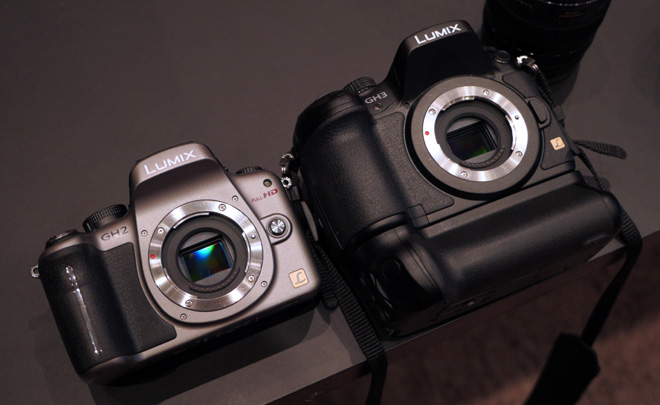
This report is based on a pre-production model.
The GH3 is Panasonic’s most far-reaching attempt yet to take on Canon’s DSLR-market domination. So popular were Canon’s DSLRs for video that they were able to found the entire Cinema EOS business on the back off it (and in doing so, arguably they turned their back on the enthusiast DSLR video market).
But there was always a dark horse and that camera was the Panasonic GH2, with a better image and feature-set than any APS-C Canon DSLR for video. Now the dark horse has come of age but question marks remain. Is the mass market educated enough to choose more discerningly when it comes to DSLRs and DSLMs?
And is the GH3 good enough?
Last Friday I was invited by Panasonic to help shoot a short documentary on the GH3 in Hamburg. This was essentially a task for us to familiarise ourselves with the latest build of the pre-production GH3, with a feedback session after the shoot.
The documentary is in the process of being edited and so will be posted later.
Takahiro Oyama of Panasonic Europe and Michiharu Uematsu of Panasonic Japan were present throughout the shoot and at dinner afterwards. We spoke pretty extensively about the GH3 and the state of the camera market.
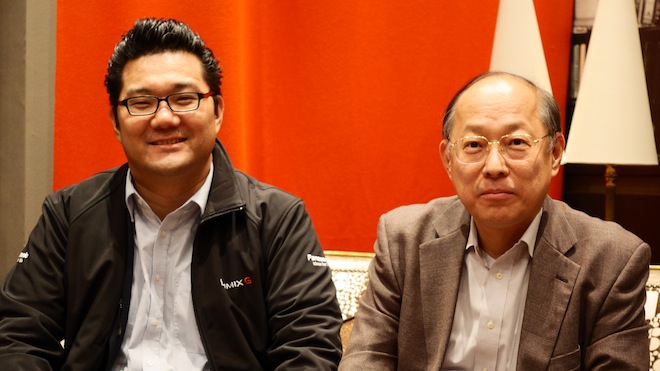
The GH3 has a new sensor, which appears to be less optimised for speed and more for image quality especially stills. On the GH2 stills were pretty good but I preferred the colour on my Canons. Maybe dynamic range and colour were a little bit compromised by a sensor which was optimised for an extremely fast readout and even a 40fps continuous shooting mode at 4MP. This has halved to 20fps on the GH3 and the readout of the sensor in video mode appears to average fewer pixels and downscale less elegantly in video mode resulting in some moire. More on that in a moment.
Like the Olympus OM-D E-M5, stills are an improvement on the GH2 and colour is now right up there with the Canon 7D. Especially in terms of noise in raw format and colour balance, the GH3 is a winner. The improved colour, smoother tones and wider dynamic range are to the benefit of the video mode too. Reduced are the halos around bright light sources and the banding of gradation between subtle shades. There’s now a smoother transition between different shades and tones in both stills and movie mode.
The EVF and LCD have had a huge upgrade too, to OLED. This is the cutting edge of current LCD panel technology, with far better viewing angles, colour, contrast than even IPS-LCD displays and much lower power consumption. They are also expensive to produce (50″ TVs with OLED panels are still a year off from being mass market and are expected to cost over $8000 initially).
Without a raw video codec, it is necessary to optimise the image with picture profiles especially if you intend to maximise dynamic range (at the expense of tonality and colour) or do heavier than normal grading work in post. The GH3’s picture profiles have changed quite dramatically. Gone are my favourites from the GH2 (Smooth, Nostalgic and Cinema Gamma). Instead they have become more in-line with Canon. Natural, Portrait, etc. with one important omission for filmmakers. I’ve asked Panasonic to add a flatter picture profile or Technicolor CineStyle to the selection and once again (at least on the pre-production model) dialling down contrast did not make the image much flatter.
Dynamic range however, and the roll off from highlights is a nice improvement on the Panasonic GH2. How much, I can’t really say until my final review and the final firmware and it wouldn’t really be fair to judge this on a pre-production model. I didn’t do any scientific tests for dynamic range either, more so the day was a real-world shoot.
Rolling shutter, especially in 1080/60p mode is faster now so you will get less jello than a Canon DSLR in video mode. However I feel that 1080/60p and a faster scan of the sensor is made possible by averaging less pixels or even line skipping. We had a long discussion about moire in video mode with Uematsu-san after the shoot. The GH1 and GH2 were superb in reducing this to a minimum, to the point where it was unnoticeable in real-world shooting and only occurred on test charts. I had quite a few examples of moire on my GH3 footage from the shoot. Here’s an example…
[vimeo]http://vimeo.com/52880775[/vimeo]Uematsu-san replied that the only surefire way to reduce moire was to read-out all pixels and oversample. He said it was preferable to reduce the pixel count to 4K (8MP). 10MP was also a good number. He cited the Aptina sensor in the Nikon 1 as capable of reading out all pixels at a frame rate fast enough for video and the Canon C300’s sensor design where each RGB photosite is output and moire is reduced. With the 16MP sensor in the GH3, this would be a tall order especially given the price point which is 1/12th of Canon’s C300, and they are not willing to compromise resolution in stills mode down to just 10MP either. This is totally understandable. But Uematsu-san also hinted at a weaker anti-aliasing filter in our conversations. This results in sharper stills but more aliasing in video mode. Indeed some high contrast near-horizontal lines on the GH3 looked stepped, which give these lines a lively animated feel in motion. This is more noticeable up close on a computer screen than in a theatre, projected, or on a TV and the benefit of a better overall image outweighed the moire problems for me. I speculate that the GH2 was averaging pixels and oversampling to produce a video readout that was higher than 1080p, and then downsampling to 1080p on the image processor. Whatever the trick, it is missing on the GH3’s sensor.
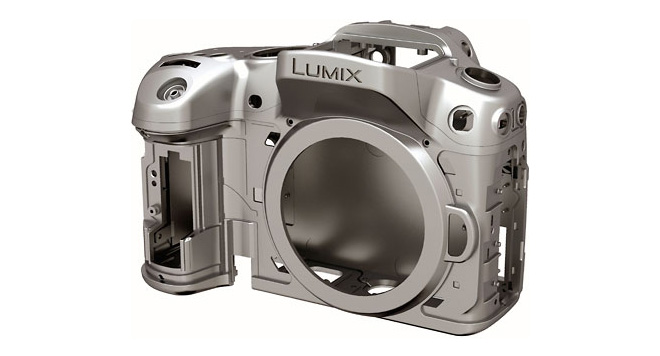
Above: The Panasonic GH3’s magnesium alloy chassis
Unlike the Sony and Canon moire which appears indiscriminately over all sorts of things like brick walls, roof tiles and asphalt, the GH3’s moire tends to limit itself to certain kinds of patterns involving very fine horizontal lines. That said, there’s also some unstable rendering of very fine textures such as grass and foliage on wide angle shots.
Whilst this is certainly not a desirable feature and a slight backwards step from the GH2, the GH3 has a better overall image because of improvements to colour, gradation and the codec.
Now for better news – the GH3 maintains the insane resolution of the GH2 in video mode. This aspect of the image in 1080p is well up there with the best 1080p cinema cameras costing many times more. It resolves more than the Sony FS100 and has a better internal codec especially in 1080/60p (with nearly double the bitrate). It resolves as much detail as the $15,000 Canon C300 and at a higher bitrate in 24p. You will not need to apply any sharping in post. The new 12-35mm F2.8 is extremely sharp. It is an expensive lens but not relative to Canon’s equivalent, the new 24-70mm F2.8 II. The Panasonic offering also has the advantage of much faster AF in live-view and video mode and silent video optimised OIS.
Global Shutter
Later I asked Uematsu-san how soon Panasonic could bring global shutter to the GH line. He told me that the global shutter is the next technology topic for the DSLM industry. He personally thinks that “in general” development of a new sensor to implement this technology will take more than 2 years. “This is a totally device related issue.” A global shutter will not nessessarily arrive in the GH3 successor.
A global shutter reads all pixels at once, simultaneously so it is very handy for video as there’s no side affects of a rolling shutter such as moire caused by line skipping or jello and skew. There are indeed image quality trade offs with a global shutter – more noise and less dynamic range. This needs to be overcome to make it all a worthwhile pursuit. The other benefit of a global shutter is that it can be used for stills, and the mechanical shutter removed entirely. Panasonic remain committed to a 100% electronic camera system, with no moving parts. The mechanical shutter in the GH3 has a limited lifespan like all mechanical shutters do and the camera has a timelapse mode built-in. But the camera can activate an electronic shutter which yields 4MP images at up to 20fps, so this is a workaround for heavy timelapse users.
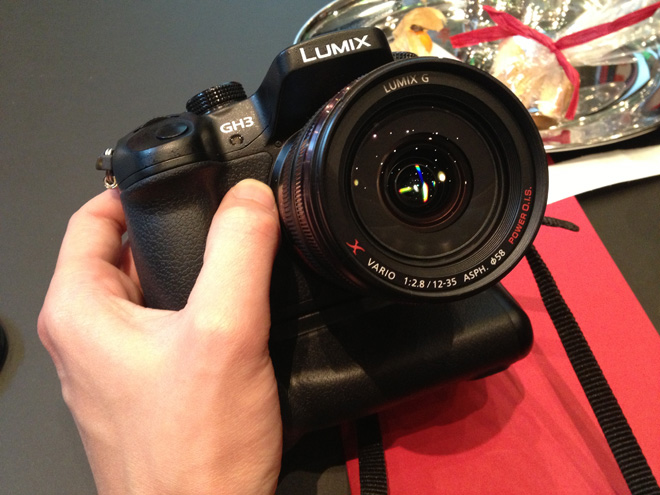
Manual focus and AF
Compared to the Canon EOS-M mirrorless camera, the GH3 is in a different league for AF performance. Aside from low contrast areas of the frame, the AF is as fast as the $6000 Nikon D4. There’s also a new one-point AF mode which acts like a semi-manual focus mode when used to shoot video. It gives you a magnified focus assist, does the focus for you whilst in magnified view, and even allows you to rack focus during a shot by touching a point on the LCD. There’s minimal hunting so it works more like a human focus puller – you can even tune the speed of this focus rack with a low, medium and high setting. The touch panel LCD also has silent exposure control features where you can drag your finger up or down to change exposure during a shot, very useful for run & gun documentary shooters.
Focus peaking was not yet implemented but Oyama-san and Uematsu-san have it jotted down in their notepads and they are getting a lot of requests for it not least from me! Don’t be surprised to see it in a later firmware update or even the final production model. One thing I’d also like to see with regards the magnified focus assist is a one-touch activation/de-activation of it, currently it takes one press to get the box up and another press to punch-in on the selected area. However there is now a rather handy step of magnification zoom that shows the punch-in focus assist in a magic window, centre frame, whilst maintaining the full frame for composition.
Placement of the AF / MF selector and AF/AE lock button is very ergonomic and you can keep your hand in the shooting position with finger over the shutter release and use your thumb to switch quickly between AF and MF. There’s also an Auto Focus Flexible (AFF) mode and AF tracking in video mode, though I found it didn’t really work fast enough to replace manual focus or a follow focus.
Codec and uncompressed HDMI
The camera was running the latest pre-production firmware, version 0.5C. 720/50/60p is now present at the highest MOV setting of ALL-I 72Mbit. A hack is no substitute for the new codec, which is superb quite frankly. 1080/60p at 50Mbit and 1080/24p at 72Mbit with intra-frame recording and both a 24p and 25p option on the PAL model is the tip of the iceberg of what is the best internal codec in any DSLR on the market today.
The new 72Mbit intra-frame codec has a subtle affect on motion, certainly it is more cinematic than the out of the box GH2 and 100% stable unlike a hacked GH2 with the GOP-1 patches. It is more suitable therefore for critical pro work. I asked Uematsu-san after the shoot whether 120fps in 720p mode would be possible with this hardware, considering how the frame rate in 1080p has doubled over the GH2 and yet remained the same in 720p. He replied that the hardware was capable and they may look at adding it in a firmware update. This however, is by no means guaranteed. I speculate that customers with slower SD cards would be an added support cost for Panasonic if such high frame rates were implemented along with the required high bitrates to maintain good image quality for each frame. But since the GH3 can conform 50/60p to internal slow-mo footage, so 720/120p is something I like to see added as a Super Slow Mo option in a later firmware update.
The external HDMI feed is clean, uncompressed 4-2-2 8bit like the Nikon D800, but Panasonic have reserved 10bit for the updated AF100A and of course the GH3 does not have professional video or audio jacks such as XLR or HD-SDI. To be honest with an internal codec this good, I can’t see there being much advantage to external HDMI recording on the GH3. The headphone jack gets in the way of the articulated screen but this can be overcome by using a monitor or EVF and keeping the LCD flat against the back of the camera or closed to preserve the battery. The microphone jack is higher up and nicely out of the way.
Although the noise grain isn’t as fine on the GH3’s new codec as on the Canon C300 or hacked GH2, it is a more cinematic grain than the 7D and 5D Mark III. The ISO performance at 3200 and 6400 is a step forward from the Panasonic GH2 with more richly saturated colour, less noise and less banding.
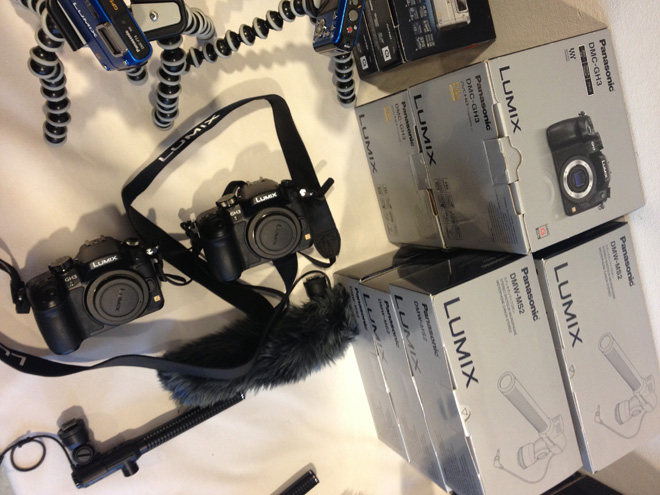
Above: the pre-production GH3 and provisional retail box, plus Lumix shotgun mic
Pre-production firmware improvements
Compared to version 0.2 and 0.5, 0.5C sees the Ex-Tele video mode almost 100% operational and it works via HDMI. Framing a shot on the LCD when Ex-Tele is activated in movie mode is now perfectly in line with the recording.
Importantly there’s now far less of a gamma switch between live-view and record mode. I really welcome this and it was something I asked for at Photokina to make exposure more accurate and in-line with how Canon DSLRs operate.
Manual audio levels have 17 steps so you really can fine tune gain for external mics, no need for a dual system recorder here!
Picture profiles can be fine tuned in 10 steps (so -5 and +5 with zero being the default). I was using Natural picture profile with Contrast and Sharpness dialled down to -5 but to be honest this didn’t seem to have much of an impact on the image in video mode. Hopefully this aspect will be improved in the final model.
Technological leaps
Cameras are computers today, and how modern their semi-conductors are is becoming more and more important especially with regards image processing the video. CMOS sensors are built in a similar way to the CPUs you find in Macs and PCs. Whilst Canon are using an old 0.5 micron process for their CMOS sensors, which caps resolution to around the 22MP mark, the GH3’s sensor is newer technology – though much of the sensor-related specifications are currently kept a closely regarded secret by Panasonic. I suspect this is because they have out-sourced the part like Nikon have on the D800. The GH3 also features a 4 core CPU, compared to Canon’s 2 core CPU in the 7D and 5D Mark III. If Panasonic’s cameras were laptops they’d be 2-3 years ahead of Canon.
Handling
The GH3 handles much like a Canon 7D with an articulated screen (whilst at the same time being weather proof, something Canon claimed was the reason for no articulated screen on the 7D and 5D Mark III). The only real compromise for the new weather proofing appears to be the internal mic which does not quite give you the same kind of raw ambience of the GH2’s stereo mic, due to being enclosed and less open to the elements.
The placement of the WB, ISO and exposure compensation buttons on the top panel is very useful and a big improvement on the GH2’s top panel. I also like the fact that the movie mode sits side by side with the M stills mode on the mode dial like the GH1, so you can once again switch quickly between the two. Unlike on the GH2, I found that almost all the creative movie mode features and codec options were available in M stills mode, handy if you are shooting stills and video at the same time.
The rear panel is larger and less confined than the GH2. There’s now 4 programmable buttons, plus 3 on the touch screen, plus an 8th if you’re using the battery grip. But on the pre-production model the functionality which can be assigned to the 4th physical button one is more limited than the extensive 10 page list of options which can be assigned to the other 3. I pointed this out and it is in the Panasonic notepad!
The rear-control dial, similar to the 5D and 7D is only semi-successful. I didn’t find myself using it very much as the shutter and aperture controls were on the top dial and top rear dial. This may confuse some Canon users. For those with big thumbs, the hand grip does not drop away from the wheel from around 12 to 5pm so it is hard to do a full 360 degrees movement of the dial in one sweep without stroking the rear grip.
The battery grip is of very high quality and features a Fn button and others such as ISO. However I couldn’t work out how to program the Fn button on this pre-production model. Though physically there is space for almost 3 batteries in the grip it only takes 1. But battery life is a MASSIVE improvement over the GH2 and after using the camera from 11am in the morning to 7pm at night, only half of one battery had been used up. I found the on/off switch on the battery grip rather confusing as it turns the buttons panel on/off not the power! But once you know that, it isn’t an issue.

Above: I enjoyed using the new 35-100mm F2.8 (constant aperture) lens. It is internally focussing and very sharp yet a fraction of the size of the full frame equivalent (i.e. Canon 70-200mm F2.8)
Pricing and release date
The GH3 is set to hit stores in late November and the UK pricing is now more in-line with Europe, at £1199 for the body compared to €1299 in Europe. The body is just $1299 in the US.
The future for Lumix
I feel that Panasonic need a full frame sensor flagship model because there is a cultural issue with customers who think bigger is always better. No matter how good the GH3, the Lumix brand will always be seen as being lesser than Canon and Nikon without that fabled full frame camera. Even if the margins are very slim and the resources required to develop a whole new lens range significant, a full frame mirrorless camera from Panasonic would have a halo affect on the whole range from top to bottom.
I’d also like to see a GH3 successor introduced higher up the product line, with a new Panasonic-made video optimised Micro Four Thirds sensor which does 4K2K for $3000, to H.264 MOV files. The product would be differentiated between more expensive Panasonic pro-camcorders through lacking an ND filter, 10bit AVC Ultra and some of the ergonomic handling of a dedicated cinema camera like the Canon C300.
Panasonic also need to shore up their compact camera division. The market has moved significantly in the direction of the iPhone and Android smart-phones. The answer I believe is not to create an Android smart-camera like Samsung or to simply add Facebook and WiFi to their Lumix cameras, but to develop a thin Apple-like premium aluminium housing with a CMOS sensor and lens as thin as the iPhone itself, which snugly fits over the back of the iPhone and uses the phone as a live-view LCD and user interface. The iPhone camera upgrade would remain on the user’s phone like a case and rather than pairing via WiFi it would interface with the phone via USB 3 or the iPhone dock as a fully integrated unit, adding the minimum of extra thickness or complexity to the phone. It would be far slimmer than a compact camera and would avoid the need for the user to carry more than one device. Since the phone is taken everywhere, and the best camera is the one you have on you – I’d happily pay to upgrade my smartphone camera.
Summary
The Panasonic GH3 is a 90% successful update to the Panasonic GH2. Here’s a provisional list of significant pros and cons relative to the GH2.
- Better stills
- Better colour and dynamic range
- Better high ISO performance
- Same insane resolution in video mode
- Best ever codec on a consumer camera
- Uncompressed HDMI
- OLED EVF and LCD
- Weather proof
- Battery grip and massively improved battery life
- Improved handling
Like all cameras, it isn’t perfect. If you’re worried about the moire issues in video mode it helps to remember what the GH3 does better than the GH2. It is a long list.
This is where the GH3 can be improved –
- A stronger anti-aliasing filter
- 720/120p super slow mo mode
- Technicolor CineStyle
- Focus peaking
- One-touch to activate punch-in manual focus assist
- More assignable options to Fn4 button


